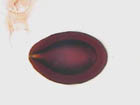Difference between revisions of "Coccidiosis - Horse"
| Line 1: | Line 1: | ||
| + | {{unfinished}} | ||
| + | |||
| + | ==Description== | ||
| + | Equine coccidiosis is an infection of the intestinal tract of equids by the protozoal organism ''Eimeria leukarti''. Infection follows the ingestion of sporulated oocysts in contaminated food or water. After exposure to bile in the small intestine, the oocysts excyst and individual sporozoites emerge. Oocysts, released as the final product of the sexual reproductive cycle are shed in the faeces and are infective to new hosts. The prepatent period is 16-35 days. Coccidia are a common incidental findings in normal foals aged 30-125 days and suggest that this organism does not cause clinical signs in foals. | ||
| + | |||
| + | ==Clinical signs== | ||
| + | Clinical signs associated with the condition occur due to the damaged intestinal epithelium and connective tissue underlying the mucosa. These may include profuse diarrhoea, weight loss, ventral oedema | ||
| + | |||
| + | |||
| + | |||
| + | |||
[[Image:Eimeria leukarti horse.jpg|thumb|right|150px|''Eimeria leukarti'' - Joaquim Castellà Veterinary Parasitology Universitat Autònoma de Barcelona]] | [[Image:Eimeria leukarti horse.jpg|thumb|right|150px|''Eimeria leukarti'' - Joaquim Castellà Veterinary Parasitology Universitat Autònoma de Barcelona]] | ||
*Only one atypical ''[[Eimeria spp.|Eimeria]]'' | *Only one atypical ''[[Eimeria spp.|Eimeria]]'' | ||
| Line 15: | Line 26: | ||
| + | ==References== | ||
| + | *Bertone, J., Horspool, L. J. I. (2004) '''Equine Clinical Pharmacology''' ''Elsevier Health Sciences'' | ||
| + | *Lavoie, J. P., Hinchcliff, K. W. (2009) '''Blackwell's Five-Minute Veterinary Consult: Equine''' ''John Wiley and Sons'' | ||
Revision as of 20:38, 23 September 2010
| This article is still under construction. |
Description
Equine coccidiosis is an infection of the intestinal tract of equids by the protozoal organism Eimeria leukarti. Infection follows the ingestion of sporulated oocysts in contaminated food or water. After exposure to bile in the small intestine, the oocysts excyst and individual sporozoites emerge. Oocysts, released as the final product of the sexual reproductive cycle are shed in the faeces and are infective to new hosts. The prepatent period is 16-35 days. Coccidia are a common incidental findings in normal foals aged 30-125 days and suggest that this organism does not cause clinical signs in foals.
Clinical signs
Clinical signs associated with the condition occur due to the damaged intestinal epithelium and connective tissue underlying the mucosa. These may include profuse diarrhoea, weight loss, ventral oedema
- Only one atypical Eimeria
- Forms large subepithelial gametocytes in villi
- Large, dark coloured oocysts
- Approximately 12μm
- Occasionally causes diarrhoea
- Besnoitia bennetti in larynx of horses
- Papilloma like lesions in larynx, skin and sclera
- Thick walled parasitic cysts, covered by hyperplastic epithelium, may be ulcerated
References
- Bertone, J., Horspool, L. J. I. (2004) Equine Clinical Pharmacology Elsevier Health Sciences
- Lavoie, J. P., Hinchcliff, K. W. (2009) Blackwell's Five-Minute Veterinary Consult: Equine John Wiley and Sons
